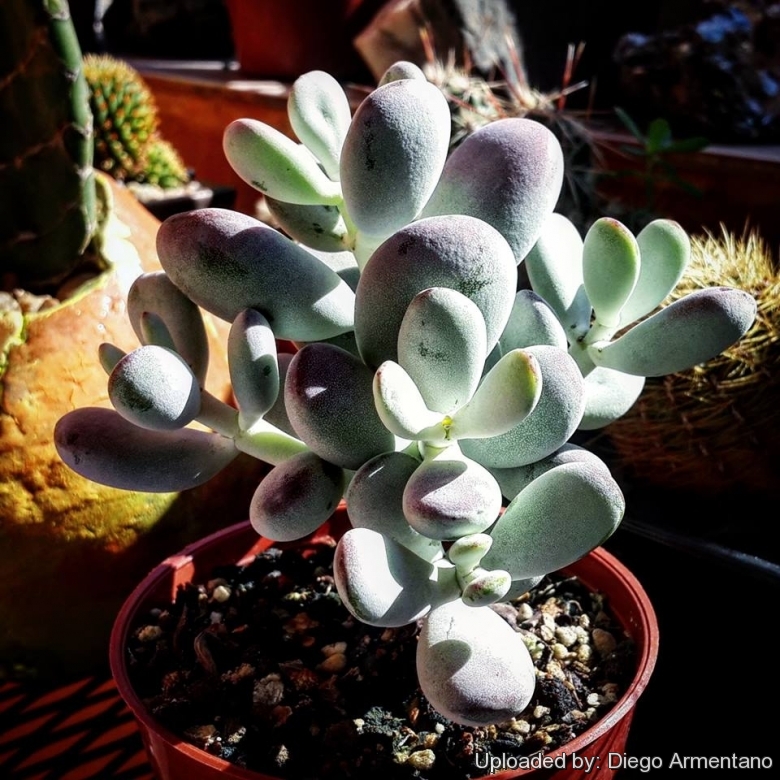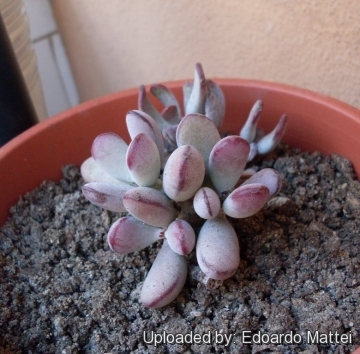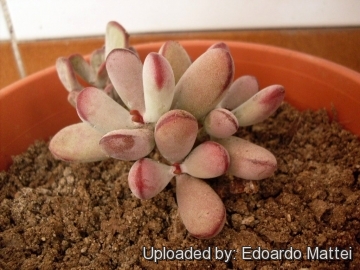Accepted Scientific Name: Cotyledon orbiculata L.
Sp. Pl. 1: 429. 1753 [1 May 1753] L.

Cotyledon orbiculata var. oophylla Photo by: Diego Armentano
Origin and Habitat: It comes from Namibia and Southwest Africa
Synonyms:
See all synonyms of Cotyledon orbiculata
Common Names include:
ENGLISH: Round-Leafed Navel-Wort, Pig's Ear
AFRIKAANS (Afrikaans): Vingerplakkie, Varkens ooren, Kouterie, Plakkie, Bergbesie, Bergbossie, Hondeoor-plakkie, Varkoor, Varkiesblaar, Nenta-bossie, Krimpsiektebos, Kotrie, Koterie, Kooltrie
CHINESE (中文): 多肉植物-寬葉福娘
Description: Cotyledon orbiculataSN|492]]SN|492]] var. oophylla is said to be a dwarf form of Cotyledon orbiculataSN|492]]SN|492]] originally published by Dinter as a variety, but now has only cultivar status. It has shorter leaves which are somewhat egg-shaped, hence the name oophylla, and bright red pendulous flowers. It one of the most popular and attractive cultivars. Leaves, stems and flowers have a waxy bloom.
Stem: Erect or reclining, fleshy, leafless, elongated, up to 25 cm ht and 2 cm in diameter, with the tips growing upward simple or once or twice divided in part often buried under ground
Leaves: Opposite, fleshy, hairless, very small short, flattened at the tips, grey-green to purple. Dusted with with a powdery waxy coating over the whole leaf that helps reflect sunlight and conserve water. Do not touch the leaves or you will damage their bloom. Margins with deep-reddish.
Flowers: In compact paniculate clusters at the end of a sturdy, erect stalk up to 45 cm long, flowers nodding, usually less than 3 cm in lengt, bell-shaped to tubular; corolla ± cylindrical with recurved lobes, externally pink, orange or dull reddish, internally of a fine flesh rose red colour, but yellow varieties also exist. The smell is very strong and something resembling that of decaying roast beef or of some of the fungi. Pollinated mainly by honeybees.
Blooming season: Winter.
Seeds: Extremely small, weighting bout 0,01 mg. These small seeds (also known as dust diaspores) can be blown about like dust particles without any special devices for buoyancy. In this species, enormous numbers of seeds are produced at the cost of fewer, larger sized seeds . Because this plant occur abundantly in the arid areas and has specific habitat requirements, the production of increased numbers of seeds is essential to enhance the probability that at least some seeds will reach a favourable germination site. Except for their small size, these diaspores generally lack other appendages to further promote dispersal by wind. Several genera of the Crassulaceae, e.g. Crassula, Tylecodon and Cotyledon, occouring in the arid areas of southern Africa have very tiny dust-like seeds. The production of numerous dust-like seeds by desert species serves as an escape strategy to prevent mass consumption of seeds. These tiny seeds are carried by the wind to cracks and furrows in the soil and are then covered with fine soil particles.
Subspecies, varieties, forms and cultivars of plants belonging to the Cotyledon orbiculata group
Bibliography: Major references and further lectures
1) John Robert Brown “Unusual Plants: 110 Spectacular Photographs of Succulents” Abbey Garden Press, 1954
2) William Richard John Dean, Suzanne Jane Milton "The Karoo: Ecological Patterns and Processes." Cambridge University Press, 24/June/1999
3) John (John C.) Manning, Colin Paterson-Jones "Field Guide to Fynbos" Struik, 2007
4) Bothalĭa: A record of contributions from the National Herbarium,- Vol. 12 - Page 615 Pretoria (South Africa). National Herbarium – 1976
5) Jacana Education “Lowveld & Kruger Guide” Jacana Media, 01/gen/2004
6) Braam Van Wyk “Photoguide - Wild Flowers of South Africa” Struik, 2000
7) “Knowledge through Color; House Plants” McGill-Queen's Press (1972)
8) William Henry Harvey “The genera of South African plants: arranged according to the natural system” Volume 1. A.S. Robertson, 1838
9) Sean Hogan “Flora: a gardener's encyclopedia” Vol. 1 Timber Press (Portland, Or.) 2003
10) Kristo Pienaar “Gardening with Indigenous Plants” Struik, 1994
11) Vandecasteele, Petra; Godard, Paul (2008). “In Celebration of Fynbos.” Struik. ISBN 1-77007-490-2.
12) Wickens, G. E. (1998). “Ecophysiology of economic plants in arid and semi-arid lands. Springer.” ISBN 3-540-52171-2.
13) L. Pappe “Florae capensis medicae prodromus, or, An enumeration of South African indigenous plants used as remedies by the colonists of the Cape of Good Hope” A. S. Robertson, 1850
14) Umberto Quattrocchi “CRC World Dictionary of Medicinal and Poisonous Plants: Common Names, Scientific Names, Eponyms, Synonyms, and Etymology” (5 Volume Set) CRC Press, 03/May/2012
 Cotyledon orbiculata var. oophylla Photo by: Edoardo Mattei
Cotyledon orbiculata var. oophylla Photo by: Edoardo Mattei Cotyledon orbiculata var. oophylla Photo by: Edoardo Mattei
Cotyledon orbiculata var. oophylla Photo by: Edoardo MatteiCultivation and Propagation: Cotyledon orbiculataSN|492]]SN|492]] var. oophylla is widely grown and not difficult to cultivate. Cotyledons are very responsive to differing cultural conditions both as regards colour, length and shape of leaves, rate of growth and size of plant.
Growth rate: Moderately fast.
Soil: It grows best in sandy-gritty soil. Good drainage is very important as it is prone to root rot.
Fertilization: Feed it once or twice during the growing season with a fertilizer specifically formulated for cactus and succulents (poor in nitrogen), including all micro nutrients and trace elements diluted to ½ the strength recommended on the label.
Watering Needs: It is a very dry-tolerant plant. Water regularly in the growing season, but avoid water-logging and let dry between watering, they should dry out completely during the rest period. The leaves have a white waxy coating over the whole leaf. To preserve this covering, plants should be watered from below. If grown in a container, bottom watering by immersing the container is recommended. It must have very dry atmosphere.
Sun Exposure: It grows in sun or part shade but flowers best in full sun. In summer keep cool and provide some shelter from direct sun during the hottest hours. In shade the body colour will remain more green, while in harsh full sun conditions the foliage can develop its characteristic blue-grey tinge. It can be sunburned if moved from shade/greenhouse into full sun too quickly. The amount of sunlight it can withstand without scorching depends upon the how hot it becomes in the summer in the locale in which it is planted.
Frost Tolerance: Light frost protection required. It requires a minimum temperature of about 5°C, but will take a light frost and is hardy down to -5° C for short periods if it is in dry soil (Lethal temperature in habitat -6 to -10 ° Celsius). USDA zones 9A – 11. In areas prone to frost, grow in an intermediate greenhouse or conservatory, in pots.
Uses: They make wonderful rocker plants in hot, dry areas and also grow well in containers or sunny patios or in a hot corner next to a swimming pool.
Traditional medicine: The Common name,'Plakkie', is Afrikaans, meaning to 'place on' from its popular and effective use as a poultice (a heated leaf) on boils, corns, warts and abscesses.
Warning: The plants are toxic because to humans and domestic animals, especially sheep and goats. Poisoning may be acute or chronic, the latter due to the cumulative effect of the toxins.
Pests and diseases: May be susceptible to mealybugs and rarely scale. Protect from cold.
Propagation: From seed but it is easily increased by cuttings. Cuttings root easily. It is also possible, to plant the leaves in good, sandy soil where they will take root - members of this family often propagate vegetatively in this way.












